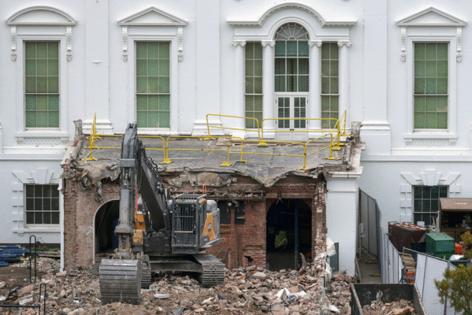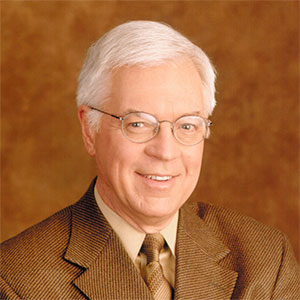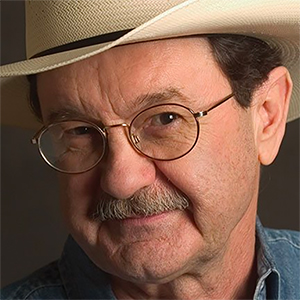Commentary: The East Wing's demolition is a lasting scar of Trump's America
Published in Op Eds
Great government houses are never still. They grow, age and change with their nations, each alteration leaving a trace of the ideals and anxieties of its time. Architecture is the archive that never stops recording. To tear down a part of it is to edit the story of who we are as a nation.
The recent demolition of the White House’s East Wing — the most consequential alteration to that building in more than a century — feels so profound, and so chilling precisely because it makes visible, in brick and dust, what happens when we lose reverence for continuity.
Every layer of paint, brick and marble holds certain truths about its makers and its era — about what was valued and what kind of future people thought they were creating. Roman concrete, for example, is a technological advancement that made possible the aqueducts, fortresses and monuments that continue to project the empire’s strength across time. Unmatched in resilience to this day, the material itself endures as a chronicle of imperial dominion.
In the same way, the buildings of my birthplace in Havana tell a story of ambition and decay intertwined. The seat of colonial rule, the Palacio de los Capitanes Generales, was begun in 1776, embodying Spain’s tenacious hold on its colonies even as others fought for independence. Its coral-stone walls, once stuccoed over, convey domination and beauty in equal measure.
Similarly, Havana’s once-elegant 20th century apartment houses — still standing, though teetering after decades of deferred care — testify to a middle class that the current government insists never existed before the revolution. Buildings, in other words, don’t bend to ideology. They tell their truths in concrete, stone and steel.
While not original to the White House, the East Wing’s lineage reaches back to Thomas Jefferson, who added covered walkways linking the residence to service buildings and framing the gardens. The current form began in 1902 under President Theodore Roosevelt and was completed in 1942 under Franklin D. Roosevelt. Many have already stated that this act of taking a wrecking ball to “the people’s house” is not simply an act of modernization, but one that mirrors this presidency’s dismantling of the democratic norms that have defined this nation’s history. I would go further: This may be the most permanent expression of that impulse — the one gesture that cannot be undone.
The ballroom that replaces the East Wing is likely to be sumptuous and bedazzling. In time, the architecture may be admired. But the walls will always carry the violence of its origin. History shows that when leaders build to glorify themselves rather than serve the public, the results reveal more about power than about the beauty of a structure or a nation. Across time, the grandest palaces and monuments conceived in hubris have come to symbolize the brittleness of the regimes that commissioned them.
It wasn’t always this way in the United States. In 1962, President John F. Kennedy convened an Ad Hoc Committee on Federal Office Space, marking a bold departure from the neoclassical style that had long defined government buildings. The committee ushered in an era of modernism — open, forward-looking, technologically confident — meant to reflect the vitality of a democratic nation at mid-century through an architecture that was transparent and in conversation with its citizens.
Not everyone loved the results; many critics, including President Donald Trump, have dismissed these buildings as “ugly.” But whether one likes them or not, the structures born of that vision — from courthouses to post offices to embassies — represented a government once willing to see itself as part of a modern world, confident enough to innovate, and to do so through collective consensus, congressional oversight and accountability. The current demolition of the East Wing represents its opposite: not progress through deliberation but change by decree. It substitutes individual vanity for public vision and replaces stewardship with spectacle.
And yet, paradoxically, this loss will ensure that we never forget the impact of these times we are living in. Trump’s ballroom will stand as an architectural scar, a reminder in limestone, marble and undoubtedly gold, of what was taken from us — not just a portion of a building, but a measure of restraint, humility and respect for the continuity of the American presidency and all it stands for.
We have to think of this in terms of history, as we have seen before. At ground zero in New York, the most eloquent memorial is not the new skyline but the absence at its heart — the twin fountains plunging into darkness, refusing closure. They tell us what happened there. So too will the void where the East Wing once stood, and whatever rises in its place.
Buildings are the truest witnesses to our values. They remember when we choose to forget. And if there is any consolation in the East Wing’s destruction, it is this: We will never again be able to look at the White House without seeing the cost of our own complicity. The new construction will not erase history. It will etch it deeper.
____
Rosa Lowinger is a fellow of the American Institute for Conservation and the Assn. for Preservation Technology and author of “Dwell Time: A Memoir of Art, Exile, and Repair.”
©2025 Los Angeles Times. Visit at latimes.com. Distributed by Tribune Content Agency, LLC.
























































Comments